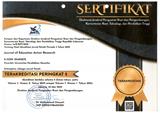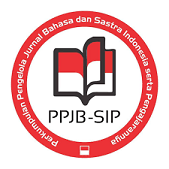Penggunaan Film Pendek untuk Meningkatkan Kemampuan Menulis Cerpen Kelas IX A SMP Negeri 1 Gerokgak
DOI:
https://doi.org/10.23887/jjpbs.v3i1.6255Abstract
Penelitian ini bertujuan mendeskripsikan (1) langkah-langkah pembelajaran menulis cerpen dengan menggunakan film pendek sebagai upaya untuk meningkatkan kemampuan menulis cerpen siswa kelas IX A SMP Negeri 1 Gerokgak; (2) hasil penggunaan film pendek sebagai upaya untuk meningkatkan kemampuan menulis cerpen siswa kelas IX A SMP Negeri 1 Gerokgak; (3) respons siswa kelas IX A SMP Negeri 1 Gerokgak dalam pembelajaran menulis cerpen dengan menggunakan film pendek. Penelitian ini terdiri atas dua siklus. Subjek penelitian ini adalah siswa kelas IX A SMP Negeri 1 Gerokgak yang berjumlah 40 orang. Metode pengumpulan data yang digunakan dalam penelitian ini adalah metode observasi, tes, dan kuesioner. Data yang diperoleh dari metode tes dan metode kuesioner dianalisis dengan teknik deskriptif kualitatif dan kuantitatif. Hasil penelitian ini menunjukkan bahwa penggunaan film pendek dapat meningkatkan kemampuan menulis cerpen siswa. Peningkatan skor rata-rata keterampilan menulis cerpen sebesar 3,40, yaitu dari rata-rata 77,30 menjadi 80,70. Hasil respons siswa sangat positif, ini dapat dilihat dari 40 orang siswa yang mengisi kuesioner, 32 atau 80% siswa memberikan respons sangat positif, 8 atau 20% siswa memberikan respons positif, dan tidak ada siswa yang memberikan respons cukup positif, kurang positif, dan sangat kurang positif terhadap penggunaan film pendek untuk meningkatkan kemampuan menulis cerpen.Kata Kunci : film pendek, menulis cerpen
This study aims to describe (1) the steps of learning to write short stories by using the short film as an effort to improve the ability to write short stories A class IX students of SMP Negeri 1 Gerokgak; (2) the results of the use of the short film as an effort to improve the ability to write short stories A class IX students of SMP Negeri 1 Gerokgak; (3) A respons class IX students of SMP Negeri 1 Gerokgak in learning to write short stories using short film. This study consisted of two cycles. The subject were students of class IX A SMP Negeri 1 Gerokgak totalling 40 people. Data collection method used in this research is the method of observation, tests and questionnaires. The data obtained from the test methods and methods questionnaires were analyzed with descriptive qualitative and quantitative techniques. Results of this study indicate that the use of short film can improve students’ ability to write short stories. An increase in the average score of 3.40 short story writing skills, ie an average of 77.30 into 80.70. Results of a student’s response is very positive, it can be seen from the 40 students who filled out a questionnaire, 32 or 80% student responded very positively, 8 or 20% of students gave positive response, and no student is responding quite positive, less positive, and very less positive towards the use of short film to improve the ability to write short stories.
keyword : short film, write short stories
Published
2015-11-06
Issue
Section
Articles
License
Authors who publish with the Jurnal Pendidikan Bahasa dan Sastra Indonesia Undiksha agree to the following terms:- Authors retain copyright and grant the journal the right of first publication with the work simultaneously licensed under a Creative Commons Attribution License (CC BY-SA 4.0) that allows others to share the work with an acknowledgment of the work's authorship and initial publication in this journal
- Authors are able to enter into separate, additional contractual arrangements for the non-exclusive distribution of the journal's published version of the work (e.g., post it to an institutional repository or publish it in a book), with an acknowledgment of its initial publication in this journal.
- Authors are permitted and encouraged to post their work online (e.g., in institutional repositories or on their website) prior to and during the submission process, as it can lead to productive exchanges, as well as earlier and greater citation of published work. (See The Effect of Open Access)







